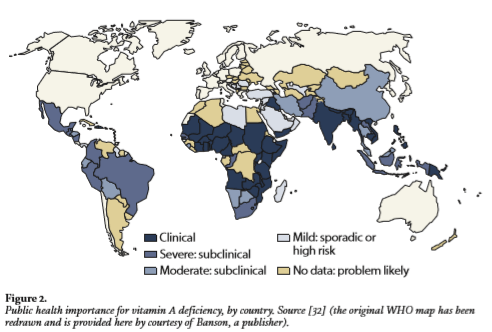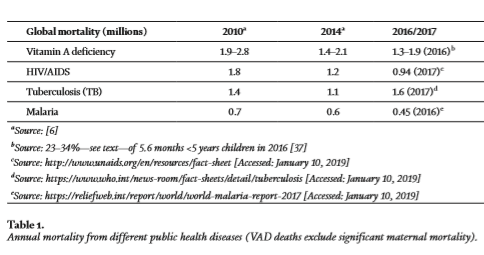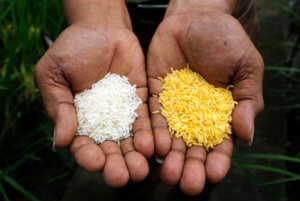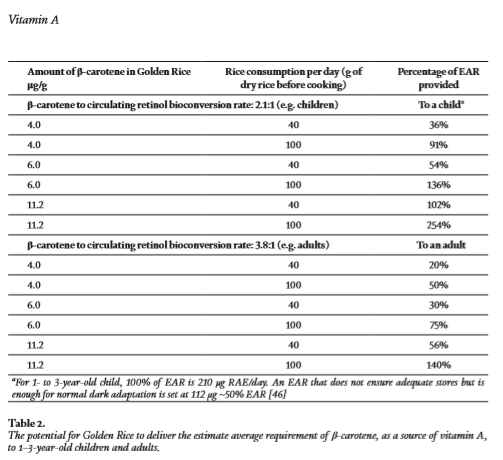For more than a quarter of a century, vitamin A deficiency (VAD) has been recognized by the United Nations as a significant public health problem. Key milestones included:
- The 1990 United Nations (UN) World Summit for Children, where 50 heads of government and senior government officials committed their governments to the virtual elimination of VAD by the year 2000.
- The 1992 UN International Conference on Nutrition, which concluded that: VAD control is the most cost-effective child health/survival strategy governments can pursue. All sectors of society should support the virtual elimination of VAD. Strategies should include promoting breast-feeding, dietary diversification, vitamin A supplementation and food fortification.Locally available food-based strategies are the first priority. Vitamin A capsule supplementation is only an interim measure.
- The 2004 United Nations International Children’s Emergency Fund (UNICEF) and the Micronutrient Initiative Report ‘Vitamin and Mineral Deficiency,’ which concluded that ‘controlling vitamin and mineral deficiency is an affordable opportunity to improve the lives of two billion people and strengthen the pulse of economic development’ and that ‘probably no other technology available today offers as large an opportunity to improve lives and accelerate development at such low cost.’
This article is part two of a four-part series on golden rice based on a book chapter Golden Rice: To Combat Vitamin A Deficiency for Public Health. Golden Rice, Part 1: The story of a GMO crop that could benefit billions of children a year; Golden Rice, Part 3: A thoroughly studied, safe and nutritionally-enhanced GMO crop approved by Australia, Canada, New Zealand and the US, but vilified by Greenpeace and ‘environmental’ activists; Part 4: Do biofortified crops make economic sense?
Nevertheless, vitamin A deficiency (VAD) remains a major public health problem, in more than half of all countries, especially in Africa and south-east Asia (Figure 2), hitting hardest young children and pregnant women especially in countries where rice is the staple food. Food sources that are most valuable in terms of micronutrients—for vitamin A, animal products including milk, eggs, butter, liver and fish—are usually more expensive and ‘beyond the reach of poor families.’ Food security staple crops such as rice are cheaper and therefore make up most of the diet.

The problem of VAD is exacerbated by the limited bioavailability of vitamin A from fruit and vegetables. It has been estimated that young children between ages 1 and 3 years would need to eat eight servings of dark green leafy vegetables per day in order to meet the recommended dietary allowance (‘RDA’) for vitamin A. These facts have resulted in the conclusion of ‘the virtual impossibility for most poor, young children to meet their vitamin A requirements through vegetable and fruit intake alone.’
VAD is the principal cause of irreversible blindness in children. Another morbidity of VAD is related to impairment of the immune system: most children and mothers who die as a result of VAD do not become blind first but die of common childhood diseases. VAD is a nutritionally acquired immune deficiency syndrome. Increased susceptibility to disease as a result of VAD results in the majority of the millions of preventable deaths annually, mainly of children less than 5 years old (<5 years). Meta-analyses have shown that 23–34% of global mortality of children <5 years can be prevented by a universally available source of vitamin A and up to 50% for measles sufferers.

As the UN regularly measures and publishes global all-cause child mortality, the importance of VAD mortality can be stated compared with other public health mortality causes, also reported regularly by the UN (Table 1). In 2016, 26 years after the first UN commitment to virtually eliminate VAD by the year 2000, and despite existing knowledge and interventions, 1.3–1.9 million, mostly children less than 5 years old, and many mothers, died from this preventable vitamin deficiency
Will Golden Rice work?
There is not one type of Golden Rice. The ‘genetic modification’ part of the process used to create Golden Rice occurred only once, in about 2004. The preferred ‘transformation event GR2E’ was selected in late 2013 and subsequently introduced by ‘conventional plant breeding’ into more than a dozen cultivars of the Oryza sativa indica rice variety agronomically adapted to and preferred by the farming and rice-consuming populations of India and Asia. These cultivars can be grown directly and harvested and the polished Golden Rice sold and consumed, or the Golden Rice seed can be used by rice breeders as ‘parents’ to introduce the trait into any locally adapted and preferred rice variety, of which there are over 20,000.
The agronomy of Golden Rice—how it grows, its resistance to pests and diseases, its water requirements and days to maturity and plant and grain morphologies—and yield are the same as the variety into which the nutritional trait has been introduced. An avoidable human error was made in an earlier selection of ‘a lead transformation event: GR2R’, which led to plants in open fields falling over when subject to wind and rain, and a small yield loss of about 2% was the result. GR2R was dropped from development in late 2013. The current lead transformation event, GR2E, was selected in the same year. GR2E has been, and will be, registered for use and has no problems associated with it.
In his wonderful book The Vitamin A Story: Lifting the Shadow of Death, the author Dr. Semba wrote (p. 159):
From a public health standpoint, for food fortification to be effective in reducing a population’s micronutrient deficiency, the food to be fortified must be a dietary staple eaten daily with little or no variation. Further, the fortified food should reach the entire population. Of course, the fortification process must be economically feasible and have minimal effect on the cost of the food treated. The micronutrient with which the staple is treated must be chemically stable and undetectable by persons consuming it. Finally, to enable observation and measurement of results, location or processing and distribution must be finite and constant.
The book was published in 2012, when biofortification was known, but not sufficiently established to have any practical history. For whatever reason, Dr. Semba does not mention biofortification, nor Golden Rice, in his book.
Nevertheless, for Golden Rice ‘from a public health standpoint, for food fortification to be effective,’ all the characteristics listed by Dr. Semba are satisfied, except when it comes to ‘undetectable by persons consuming it.’ The Golden Rice color is caused by the β-carotene content, a source of vitamin A for humans, which in Golden Rice is about 80–90% of all carotenoids. It is the same β-carotene which colors mangos, papaya, squash and carrots, all of which consumers readily accept, and there is no taste associated with the β-carotene content. In Golden Rice, the intensity of the color is proportional to the β-carotene content. The color is obvious and cannot be ignored

In 2009 MBA students at the Asian Institute of Management conducted qualitative attitudinal surveys of small farmers and consumers in four different representative island locations in the Philippines. Neither the color nor the way it was created was considered a block to trying Golden Rice, so long as it was expected to assist their family’s health and was affordable. The solid color of Golden Rice was recognizably distinct from the rather blotchy yellow color of poorly stored white rice, which is sometimes offered cheaply by governments to assist poor people.
From several perspectives the color of Golden Rice is positive. Consumers have a choice about whether to select it for cooking and whether to consume it or not. Such consumer choice is denied and therefore only made by governments or plant breeders, when the biofortified trait is ‘undetectable by persons consuming it,’ as in the case of invisible biofortificants such as iron or zinc introduced into biofortified grain crops or used in fortification of processed food. The color of Golden Rice makes the consumers’ choice clear, even in populations with a variety of languages and dialects or where individuals are illiterate: each grain of Golden Rice is individually labelled, by its color. No labeling is required on any packaging, and preference can be beneficially affected by communication of its lack of any adverse associations, and anticipated health benefits, from consumption.
Eighty percent—about 380 million tonnes—of global rice production is produced on small farms for family consumption, usually unprocessed except for polishing. It is probably not stored for long, as rice is produced, usually, in two or three growth cycles annually, and storage facilities are limited. Data have shown that degradation of the β-carotene is minimal 2 months after harvest and samples of Golden Rice stored in ambient temperatures for 4.5 years remain noticeably yellow, indicating continued presence of β-carotene.
In early 2001, a year after the seminal paper describing the ‘proof of concept’ technology, Greenpeace made a press release:
Genetically modified “Golden Rice” containing provitamin A will not solve the problem of malnutrition in developing countries… Greenpeace calculations show….that an adult would have to eat at least 3.7 kilos of dry weight rice, i.e. around 9 kilos of cooked rice, to satisfy their daily need of vitamin A from “Golden Rice….
It is unclear how Greenpeace came to their conclusion. At the time, it was known that the bioavailability of carotenoids is influenced by nine different factors. But no one knew how efficiently the β-carotene in Golden Rice was converted to circulating vitamin A, retinol, by human adults or children. And nutritionists agreed that animal models would not be helpful because animals metabolize carotenoids differently than humans. Research was needed to determine how efficiently the β-carotene in Golden Rice is converted to circulating retinol, in children in developing countries where rice is the staple, the population segment which suffers most from VAD.
A February 2002 grant application to the US governments National Institutes of Health (NIH) for a project, which is entitled ‘Retinol Equivalents of Plant Carotenoids in Chinese Children,’ states: ‘This project is to determine the vitamin A value (equivalence) of dietary provitamin A carotenes from spinach, Golden Rice, and pure β-carotene (β-c) in oil. These experiments will be conducted in children (ages 6–8) with/without adequate vitamin A nutrition.’
On February 10, 2004, Tufts University Institutional Review Board (IRB) approved the research Protocol for ‘Retinol Equivalents of Plant carotenoids in Chinese Children’ and noted that ‘The Zhejiang Academy of Medical Sciences [China] approval is on file’.
On March 11, 2008, the Tufts IRB reviewed and on May 10, 2008, approved the study ‘Vitamin A Value of Plant Carotenoids (Spinach and Golden Rice in Children)’ based on the Protocol ‘Retinol equivalents of plant carotenoids in Chinese children.’ Both Protocols referenced ‘NIH grant proposal 1R01 DK060021.’
On March 30, 2008, with respect to ‘Retinol Equivalents of Plant carotenoids in Chinese Children’ and ‘NIH Grant 1R01 DK060021-01:’ The Ethical Review Committee of Zhejiang Academy of Medical Sciences confirmed that they had ‘reviewed the proposed use of human subject identified on June 27, 2003’ and certified that ‘the approval notice is still valid.’
Although the Chinese children research was planned in 2003, various practical setbacks in the production of the deuterium-labelled Golden Rice meant that the field work in China was not completed until mid-June 2008 and, due to the complexity of analysis combined with limited analytical resources, publication not until 2012.
In the meantime, similar research was approved and conducted with adult volunteers in the USA. Data confirmed that 3.8 molecules of β-carotene derived by consumption of a single meal of Golden Rice converted to one molecule of circulating retinol; this 3.8:1 bioconversion compared very favorably with conversion ratios established using other plant sources. When the Chinese children research were published online on August 8, 2012, the authors reported a bioconversion ratio of 2.3:1.0, later adjusted to 2.1:1.0, and neither ratio was significantly different, statistically, from the 2.0:1.0 of β-carotene in oil, another treatment in the same research. A third treatment, spinach, showed a 7.5:1.0 conversion.
In each case the sophisticated research design measured the efficiency of conversion of β-carotene to circulating retinol following a single meal containing the β-carotene source. The publication noted that:
In summary, the high bioconversion efficiency of Golden Rice β-carotene to vitamin A shows that this rice can be used as a source of vitamin A. Golden Rice may be as useful as a source of preformed vitamin A from vitamin A capsules, eggs or milk to overcome VAD in rice-consuming populations.
These results were clearly very different from Greenpeace’s 2001 prediction. Instead of welcoming the excellent news of a potentially useful additional VAD intervention, Greenpeace, on August 29, 2012, issued a further press release in China from their Netherlands HQ: ‘Greenpeace alarmed at US-backed GE food trial on Chinese children’
….It is incredibly disturbing to think that an American research body used Chinese children as guinea pigs for genetically engineered food… The relevance of this study is questionable…Nor does high conversion rate solve all the technical, environmental and ethical issues around Golden Rice.’
Greenpeace claimed that the Chinese authorities agreed to halt the research before it started but were unable to substantiate their claim to an independent journalist. The press release created hysteria in China and, 4 years after the field research had been completed, caused the parents of the subject children consternation.
Tufts University IRB carried out an investigation and concluded that there were
no concerns related to the integrity of the study data, the accuracy of the research results or the safety of the research subjects. In fact, the study indicated that a single serving of the test product, Golden Rice, could provide greater than 50 percent of the recommended daily intake of vitamin A in these children, which could significantly improve health outcomes if adopted as a dietary regimen.
Tufts also noted that ‘the research itself was found not to have been conducted in full compliance with IRB policy or federal regulations. ‘ Eventually following this Greenpeace Press release, Tang et al. (2012) was retracted by the American Society of Clinical Nutrition in 2015 for procedural reasons. The full details of this and other impediments to Golden Rice’s development are given elsewhere.
Separately, the Chair of the Tufts IRB, a computer scientist, in complaint to the publisher of one critical review of the case, wrote: ‘There was no research ethics committee or IRB review and approval in effect for the study when it was conducted in 2008.’ This gross error of fact, with reference to the NIH grant and related IRB authorizations quoted above, itself calls into question the professionalism or objectivity of the 2012 Tufts IRB review which led to the retraction.
Henry Miller, a physician, molecular biologist and the founding director of the US Food and Drug Administration [Office of Biotechnology], commented in 2015 on the retracted paper:
A 2012 article in the nutrition literature might have been the most momentous contribution to public health worldwide since Dr. Jonas Salk’s announcement of the polio vaccine. The operative phrase is might have been, because intimidation, politics and the dishonest, anti-science efforts of NGOs to impugn the research have delayed the translation of its findings to life-saving interventions for millions of children. Why do anti-genetic engineering activists want to save the whales but let children go blind and die?
The data generated by the above-mentioned research allow determination of the proportion of the estimated average requirement (EAR) the β-carotene content of Golden Rice can provide to children and adults.

If Golden Rice was the sole source of β-carotene in the diet, 50% of the EAR is sufficient to combat VAD. Many nutritionists consider that supply of 30–40% of the EAR will be sufficient to combat VAD because the biofortified staple crop is seldom the only source of β-carotene.
Adrian Dubock holds a PhD from Reading University in reproductive physiology and ecology. He is the executive secretary of the Golden Rice Humanitarian Board































